
Last modified: 2014-11-15 by pete loeser
Keywords: ufe | unidentified flags | 2013 |
Links: FOTW homepage |
search |
disclaimer and copyright |
write us |
mirrors
Please note our Policy for Submissions and Enquiries.
Below is a series of images of flags that have been provided to FOTW; some we have recognized, and some we have been unable to recognize. If you can help us identify any of these flags, please let us know! Contact the: UFE Editor.
Identification Key:
 Image from Jaume Ollé, 27 January, 2013
Image from Jaume Ollé, 27 January, 2013
Click image to enlarge - Source: HistoryImages.blogspot.com
Pictured are four captured Japanese flags that I can't identify. Can anyone?
Jaume Ollé, 27 January, 2013
The caption reads: "Russian sailors with captured Japanese flags." There is no other information regarding the photograph, except that the page context is Operation August Storm, the Soviet operation against Japan's mainland conquests, directly following the destruction of Hiroshima in August of 1945.
Peter Hans van den Muijzenberg, 28 January 2013
Well, let's see what we can add:
- The flag to the viewers right is the only one that is actually intended to be vertical, but the tag hanging in front of it makes it impossible to read the character. At first sight it would appear to have two zigzag lines, as more Japanese flags have (Does anyone know more about what those stand for?), but a closer look reveals an extra line
above, and the two dark lines might not be the exact same colour. The flag held by the second flag from the viewer's left follow this patterns with its lines as well. Though the colours can't be determined exactly, they would seem to follow the pattern on the flag of Manchukuo. Indeed, this matches the location of Japanese mainland conquests. The "tag" hanging in front of it would probably tell us all we wanted to know, but unfortunately it can't be read in the photograph.
- The Second flag from the viewers left has the same colours running as four lines across the flag. In this case the colour of the field really seems a bit darker than what would be the white stripe, so I expect this to be mustard yellow. The order of the lines tells us the Russian sailor is probably holding the flag the wrong way round. The flag is longer even then it would seem; his gun prevents him from holding it up properly. In reality the badge is likely to be in the centre of an 1:2 flag. The structure of the ring gives the impression of a very short circular rail road. That's not the common style for rail road emblems, though, and the flag isn't mentioned on Japanese controlled transport companies (China). It may well have a different meaning entirely, though I can't shake the feeling I've seen it somewhere before. Though the reverse of the flag, the character seems to be correct; at the moment I can't come up with its meaning, though. Anyone?
- First to the viewer's left. Definitely saw a wreath like that before, but where?
- Second from the viewer's right; I'm tempted to say this one is held the wrong way as well, as the character would seem to read best from the viewer's right. It's still unreadable because of the folds, though. Comparing with the other flags, I'd go for blue thick border, than white then black inner border, with a mustard yellow field and red character. The blue and red aren't all that certain, though.
Peter Hans van den Muijzenberg, 3 February 2012
 #2
#2
 #2a
#2a
Images from Jerry Ashe, 1 February 2013
I recently purchased a trunk at an auction that contained World War II U.S. Naval uniforms and there were two flags in the bottom of the trunk. It appears that one of them (White with a blue cross) has a Japanese symbol in one corner. The other flag is square with a red cross no markings. My question is can you tell me what the symbol on the pennant means, what type of flag ?
Jerry Ashe, 1 February 2013
The top flag looks like the signal flag "V" to me, but the blue cross pennant I don't recognise.
Rob Raeside, 1 February 2012
Far from being even close to reading Kanji characters, it seems to me that it may be the one that mean "no", "negative", "deny"... I seems to remember seeing such pennant in some of the signal flag charts, but haven't found it (in quick search) in any that we have on FOTW. It would probably been used indeed in signaling negative answer.
Rob's guess for the square flag is as good as mine... Certainly, both flags looks like part of the maritime signal code.
Željko Heimer, 1 February 2012
From the top of my head: This is a signal flag from the Imperial Japanese Navy, the Mi pennant. It's hoisted to qualify the rest of the signal as navigation information. I would say that symbol means "Negative". It might serve a double function. Each of their signal flags seems to have combined several meanings.
The other square flag with a red cross is the V, as Rob said. If it belong with the other one, it will have had some
specific Japanese meanings as well.
Peter Hans van den Muijzenberg, 1 February 2013
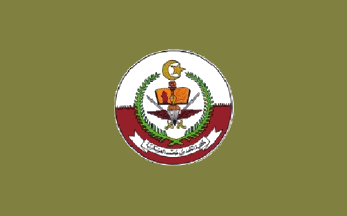 #13a
#13a
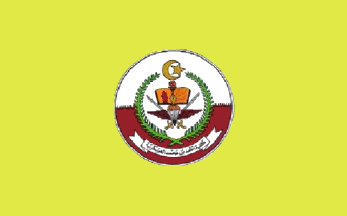 #13b
#13b
Images from Ruppert Baird, 3 February 2013
This morning while watching TV in my hotel room in Abu Dhabi I saw on Qatar TV a military graduation ceremony of the Ahmed bin Mohammed Military College. During the cremonies I saw two flags containing the college's crest. The dimensions of each appeared to be 3:5, and they appeared identical except for the main colors which looked to be a medium olive green and a lighter olive green, almost tan. All services were represented at the parade and ceremony although all the graduates wore the same uniform, so determining what each banner represents is impossible for me. I did NOT see any other flags except the national flag. Sorry for the roughness of the crests. I downloaded them from the college's FB page.
Ruppert Baird, Senior Supervisor - AMMROC, Abu Dhabi, UAE Limestone College Alumni, 3 February 2013
Well, here's a better image resolution for the CoA, and here they mention that the first graduates from this Academy were in 2001. Finally, you can see pictures of the Qatar National Day Parade 2012 with some of their flags shown.
Esteban Rivera, 3 February 2013
 Image from Esteban Rivera, 21 Jan 2013
Image from Esteban Rivera, 21 Jan 2013
Today there's a picture which shows what seems to be a political flag, since they were used in the last week of elections according to this BBC article. Can anybody identifiy this flag?
Esteban Rivera, 21 Jan 2013
 Image from J. Patrick Fischer, 7 February 2013
Image from J. Patrick Fischer, 7 February 2013
A young Moroccan man demonstrated on the statue of Don Juan d'Austria in Regensburg/Germany against the statue. He raised two flags on the statue: The Turkish national flag and a horizontal triband in green-white-green. The newspaper article noted that this flag would be a Moroccan. Does anybody know this flag?
Jan Patrick Fischer, 7 February 2013
Well, it looks a bit like a Nigerian banner, doesn't it? Probably is something else entirely, though. However, I don't see mentioned that the flag is Moroccan, just that the protester was.
Peter Hans van den Muijzenberg, 7 February 2013
Strangely enough, its a perfect match to the Naval Ensign of Argentina used by Hippolyte de Boucharda when his two warships occupied Monterey (California) between November 24 to November 29, 1818. The sun emblem was first added to the War and Naval Ensign of Argentina in February of 1818, but de Bouchardas' squadron had already sailed, so they most likely were still using an older version without the emblem. (see: "The War and Naval Ensign of Argentina 1818") Could there possibly be any connection to Argentina at this Regensburg protest?
Pete Loeser, 7 February 2013
It looks like the flag is on the statue itself, the protester has a the Turkish flag, but his other arm is down and empty. And the green-white-green horizontal is larger too. Looks like it is regularly part of the statue, but this is a guess.
Lee Herold, 7 February 2013
It really isn't. The protester taped the flags to the hands of the statue.
Peter Hans van den Muijzenberg, 7 February 2013
Could be the flag of Andalusia, just across the Strait.
Rob Raeside, 7 February 2013
A further note on a possible Argentine connection from the FOTW database: "Before 1985, the citizens had to use the flag without sun emblem. The flag with sun could be raised just by the government and the Armed Forces." As previously noted, the colors on the protestor´s flag match those used on many modern Argentine flags, however, I personally doubt there is any connection here, the colors are most likely just coincidental.
Pete Loeser, 7 February 2013
While I don't know what the protester intended, the flag of Andalusia would indeed be a logical and plausible partner to the Turkish flag. John of Austria's two most notable achievements were the defeat of the Ottoman fleet at Lepanto and the suppression of the revolt of the Moriscos of Granada in Andalusia.
Ned Smith, 7 February 2013
That emblem is not totally clear, but if it is a hexagram, then in an Islamic context it would more likely be intended as six-pointed "Seal of Solomon" rather than a Star of David. See for example:
The emblem on the flag in the news photos is very faint, and looks as if it was hand-drawn on the flag. Since the seal is often associated specifically with Moroccoo, perhaps this was intended as a revanchist statement - "Andalusia is Moroccan!" or something like that.According to "Minuto Digital", 13 February 2013, the man is a Muslim Moroccan who "seized" the statue of Don Juan of Austria in Regensburg and asked for its removal from public space. The man hold the flags of Andalusia and Turkey.
Ivan Sache, 14 February 2013
The article does say: una bandera turca y otra de Andalucía (a Turkish flag and another of Andalusia). I guess with the addition of a star of David it would seem the most logical that it's supposed to represent Moorish Andalusia.
Peter Hans van den Muijzenberg, 14 February 2012
Is it a hexagram or a pentagram? The latter indeed would have something to do with Morocco? Or is it something else - a rdinat sun?
Klaus-Michael Schneider, 14 February 2012
In this larger photo I can see the Turkish flag taped to the belly of the statue and the Andalusian flag (defaced with the hand-drawn Star of David?) in the right hand of the statue, but are we sure the flag in the left hand is the Turkish one, all I can see is the red field [and what appears to be something gold in the canton. It could also be a Communist flag, for example].
Pete Loeser, 15 February 2013
The explanations are those given by the source, not my own interpretation.
Ivan Sache, 15 February 2013
It must be an eight-pointed star; with this star (and an "A" in the center) is the flag of Andalusian Assembly, a group that favour the Islamic heritage of the country.
Jaume Ollé, 15 February, 2013
Yup: See the Andalusian Assembly Flag.
Eugene Ipavec, 19 February 2013
 Image from Stephen Collier, 7 February 2013
Image from Stephen Collier, 7 February 2013
I was wondering if you could help identify a flag for me. I was told at the estate sale where I purchased the item, that it is a Japanese Navy flag from around 1918. It is hand sewn and hand panted. Any help would be appreciated. Attached are some images of the flag.
Stephen Collier, 7 February 2013
I don't think this flag is Japanese, but I might be wrong. I think the characters are Chinese, and triangular flags are more often found historically in China than in Japan.
Rob Raeside, 7 February 2013
This is probably a Daoist/Taoist religious festival flag from somewhere in China. The writings literally mean "Middle City Triple Compassion Water Festival Flag".
Miles Li, 7 February 2013
 Image by Rob Raeside, 9 February 2013
Image by Rob Raeside, 9 February 2013
Sent to me off-list - an odd Spanish flag. Any ideas? To me it looks like a parody of the flag with arms as at the lion and castle of Castile y Leon. But is that a lion or a bull?
There are also the flags with the red-yellow-red and a plain black bull - see National Flag with Osborne's Bull, Spain. I wonder if this flag is of that type?
Rob Raeside, 9 February 2013
I think it is a lion - when zoomed in enough, it seems to reveal the mane.
Tomislav Todorovic, 9 February 2013
This is a manufacturers variant of the Spanish flag adopted in 1785, likely based on a description rather then an image. It is, or was when I first saw it in the 1980s, made by Annin & Co. as a part of a historical set of flags to represent the period of Spanish sovereignty over some part of the southern U.S., Texas or Florida perhaps. It was available full size for outdoor use and as miniature table flag.
On a visit to Annin's Verona NJ manufacturing plant in the 1980s. I pointed out that Annin also already made the correct flag for the 1785- 1931 period and that they should correctly substitute that. I was told that this was what the customer had used in the past, this is what they were used to and that this is what they wanted. This is a perfect example of what William Crampton referred to as a suppositious flag - something erroneous, but used do often it is accepted as factual.
Many parts of the U.S. use historical flag reproductions to indicate the various ruling powers that held sway at one time or another, not all are historically faithful to the flags actually used in that period, and often their modern replacements are used as a cost saving.
Jim Ferrigan, 9 February 2013
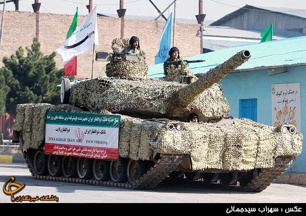 Image from Esteban Rivera, 11 February 2013
Image from Esteban Rivera, 11 February 2013
During the presentation of the Zolfaghar (also Zulfiqar) Iran MBT (Main Battle Tank), an Iranian military UFE can be seen on top of this prototype. The flag on a white horizontal background, shows a black
Zulfiqar "bifurcated" Sword of Ali with a green inscription I cannot understand.
Esteban Rivera, 11 February 2013
 Image from Juanito C., 14 February 2013
Image from Juanito C., 14 February 2013
(Click on image to enlarge)
I recently bought a book called "Adolf Hiter" by John Toland (ISBN: 0385037244), and while flipping through the pages I came across some German Flags which I think are German. One Flag (very top on left side) seems to be a Hammer and Sickle which seems like a Soviet Version, but then again it might just be a Communist/Marxist Party flag. Two flags which seem to have a skull and maybe crossed bones?, at different positions on the flag. And lastly a flag which looks like the letter "M", but since it being hung from a window it looks more like the number 3. I couldn't find theses flag on the Third German Empire page or find anything similar to them. I am hoping that someone will identify these flags.
Juanito C., 14 February 2013
It is communist flag, showing hammer and sickle, but it's hanging with the top side next to the building.
Valentin Poposki, 14 February 2013
In addition, enlarging the ones looking like skull and cross bones a bit reveals that they are probably hammer & sickles too. I can't be entirely positive because the images gets too grainy, but that is what they seem to be, and that would match the caption about Nazis and Marxists joining in a tenants strike (obviously before the Nazis took power, when it was in both groups' interest to promote unrest).
Ned Smith, 15 February 2013
 Image from Jaume Ollé, 16 February 2013
Image from Jaume Ollé, 16 February 2013
I attach a photo of a strange revolutionary flag from Sao Paulo in 1932. The colors are uncertain. There are at least two possibilities: Yellow-green-yellow (Brazilian colors) and white-blue-white (Federalist colors).
I attach here a partial image (only the flag). Any suggestions?
Jaume Ollé, 16 February 2013
 #11a
#11a
 #11b hoist label detail
#11b hoist label detail
Images from Jim Hopkins, 18 February 2013
[Cropped and rotated by UFE Editor]
This flag is military issue and believed from World War II. The person I bought it from was told it was a Canadian 1st Corps Command Headquarters flag. I have been told that is incorrect. I have since inquired on three boards, but nobody has been able to nail down where this flag was used. I would like to include it in your unidentified section to see if any of your followers can identify this flag.
Jim Hopkins, 18 February 2013
This is almost certainly the 1947 proposal for the Canadian Nation Flag, although the field colours appear to be reversed.
Rob Raeside, 9 February 2013
Although it has been proposed that this flag is the 1947 Proposed National Flag, it is not the same flag. The colors are opposite on my flag and the maple leaf is a different shape.
Jim Hopkins, 23 February 2013
Can anybody make out what's printed on the hoist detail in #11b?
Pete Loeser, 23 February 2013
The hoist has the C Broad Arrow stamp that means it is military issue.
Jim Hopkins, 23 February 2013
 Image from Stacy Bjorhus, 20 February 2013
Image from Stacy Bjorhus, 20 February 2013
I have a swallowtail pennant that I can not get any information about (it is 30" X 60"). Can you help me with information on this swallowtail pennant.
Stacy Bjorhus, 20 February 2013


Images from Brian Hill, 19 December 2013
Could this be a pennant for the Dordrechtse (Netherlands) Football Club.
Sources: CataWiki (pennant) and CataWiki (pin)
There are other European football clubs with the initials DFC and the same red and black color scheme, so those could be additional possibilities.
Brian Hill, 19 December 2013
 Image from Graham Chick, 25 February 2013
Image from Graham Chick, 25 February 2013
I came across this British West Africa flag. It measures 16" x 7", and judging by the 1939 reference it is something to do with our presence (I'm ex-British Army) during World War II, but I can't find anything about it…any ideas??
Graham Chick, 25 February 2013
The four British colonies in West Africa were quite separate. The only(?) thing in common was their currency, the British West African Pound. The keys, ‘guineas’, padlocked gate suggest a connection with the Bank of British West Africa. Also see British West African Pound.
David Prothero, 25 February 2013
This flag looks to be of similar style to those produced by the Asafo - African Flags of the Fante, which is a military institution of the Akan peoples of west Africa, mainly from Ghana. In 1992 an excellent book was published about these, and number of these flags featured in a world tour in the mid-1990's. I viewed this exhibition in The Netherlands shortly after attending ICV 16 - Warsaw in mid-1995.
Ralph Bartlett, 26 February 2013
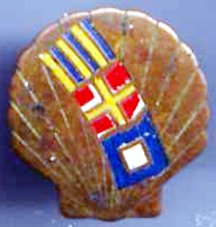 Image from Mark K. Baskerville, 25 Feburary 2013
Image from Mark K. Baskerville, 25 Feburary 2013
I came across this pin. I'm trying to identify it. I'm wondering if it is connected to the Shell Oil Tanker Fleet. It has a shell which looks like the Shell Oil logo. It has signal flags with the letters "G - R - P". I contacted a Dutch sailor who worked on Shell tankers in the 1970's. He said it did not look familiar to him. Any help greatly appreciated.
Mark K. Baskerville, 25 Feburary 2013
Although the pin is obviously a scallop shell, I would be surprised if it is a Shell Oil Fleet Pin - I would expect them to use the Shell Oil colours, yellow and red. The scallop is also used in heraldry and does appear on some flags. Its best known use is in connection with the Camino de Santiago, Spain. The C letters are correctly identified.
Rob Raeside, 15 February 2013
 Image from Pete Loeser, 28 Feburary 2013
Image from Pete Loeser, 28 Feburary 2013
Since we don't seem to have the Shell Oil Company flag on FOTW, here is what it looks like in the United States. Obviously, not any kind of a match. We also see Shell Tankers in the Netherlands and British Shipping and Shell Tankers.
If we look for "scallops on flags", we do have the City of Olesa de Bonesvalls in Spain, and the Morissen Commune in Switzerland, but again no obvious connection. So the search must continue...humm GRP and scallops...It's time for lunch.
Pete Loeser, 28 February 2013
This is a case of flags on a scallop, and the flags are correctly identified from the start. Is there any reason to think this pin represents some unidentified flag?
Ned Smith, 1 March 2013
Point taken. Actually, we do have three identified flags on a scallop-shaped pin, but the question is more about what the GRP stands for now, wouldn't you say? Perhaps it is simply somebody's initials on a piece of custom jewelry, but it might also be something more.
Pete Loeser, 1 March 2013
But the same could be said of any unknown monogram, logo, or what not. In my opinion, including things like this under Unidentified Flags or Ensigns is seriously misleading unless we have some cause to believe that they are carried on some actual or fictional flag somewhere. As it stands now it seems to be saying to our readers that FOTW judges that there is a flag somewhere which resembles this pin, and we have no known grounds to make that judgment as far as I can see.
Ned Smith, 2 March 2013
 Image from Andy Behrens, 8 March 2013
Image from Andy Behrens, 8 March 2013
The shell does represent Shell Oil, and the signal flags "GRP" are the old signal code for "Give Way". This is a license-plate ornament that was given out by Shell dealers as part of an advertising campaign to promote courteous driving habits.
Andy Behrens, 8 March 2013
The Royal Dutch Shell plc (commonly known as Shell), is an Anglo-Dutch multinational oil and gas company incorporated in the United Kingdom and headquartered in the Netherlands. Created in 1907 by the merger of Royal Dutch Petroleum and Shell Transport & Trading, it is the largest company in the world, in terms of revenue, and one of the six oil and gas "supermajors"
On March 2, 2014, I found several pictures with the official Shell flag (See the picture of the flag in their Amsterdam office and the picture of the flag in their London office)
The official flag is a horizontal flag with a yellow vertical stripe on the mast, then a vertical red stripe (half in size regarding the yellow stripe) and then the rest of the horizontal white flag bears the logo in the middle. (Source: Name and logo)
Thus, this topic of discussion should have this information added to it, and then moved to a section of commercial flags inside these two countries, Netherlands and UK.
Esteban Rivera, 23 March 2014
 Image from Mike Robinson, 2 March 2013
Image from Mike Robinson, 2 March 2013
I was hoping you could help me identify this pennant? It is approximately 19 1/2" long x 11 1/2" tall and is sewn together from different sections of cloth. Any information would be greatly appreciated.
Mike Robinson, 2 March 2013
My guess is that this pennant is associated with a yacht called Venture II, and may be difficult to locate.
Rob Raeside, 2 March 2013
Well, I agree with Rob that this looks like a name pennant. Usually, a name pennant stays with the ship. It would be interesting to know what Mike's relation to the pennant is, and what history is known about it.
There was a Venture II of some fame in the 1950s, I think: An 8-meter yacht that won the Canada's Cup for Canada. Come to think of it, when they changed the rules, I think I saw a mention of it still sailing on Lake Ontario. Might be a completely different Venture II, of course.
Peter Hans van den Muijzenberg, 12 July 2013
 Image from Andrew Potter, 11 March 2013
Image from Andrew Potter, 11 March 2013
(Enlarged ensign insert added by Rob Raeside)
It has been suggested that you might be able to identify the defaced ensign and yacht in the attached pictures. If you can help it would be very much appreciated, if I am completely up a gum tree my apologies for bothering you. (Pictures dated 1884. Location Naples).
Andrew Potter, 11 March 2013
It looks like the badge is a crown above a St. George's cross shield.
Rob Raeside, 11 March 2013
It probably doesn't help much, but it would seem very likely to be the ensign of a yacht club - one of the many with "Royal" as part of their name.
James Dignan, 11 March 2013
The defaced Blue Ensign, racing rig and apparent tonnage would indicate a fairly substantial private yacht, and the nearest match (to the defaced ensign) I can find would suggest that her owner belonged to the Royal London Yacht Club (with its present headquarters at Cowes)?
I don't know on what date this club received an Admiralty Warrant for its defaced ensign (although the club was founded in 1838), and I cannot tell if the red dagger (representing the one that killed Watt Tyler during the Peasant's Revolt, if I remember rightly) appears on the shield's first quarter in the painting. The crown in the painting appears to be a representation of the Imperial State Crown which is correct for 1884, whilst the current pattern shows the King Edward's Crown introduced in 1952, this however, is totally irrelevant since (in my experience) the actual design of a crown was usually not stipulated on such Warrants – these simply saying something like "...beneath a royal crown" which leaves you in a position to use the modern pattern or the one current at the date the Warrant was issued as you choose?
A lot of question marks there, but I hope that it is of some use?
Christopher Southworth, 12 March 2013
 Image from Esteban Rivera, 15 March 2012
Image from Esteban Rivera, 15 March 2012
(Image cropped by UFE Editor)
This flag was flown at Zhukovskiy (Moscow Oblast region) next to an S-300PMU2 missile system on display. In the picture, taken on Agusut 21, 2005, one can see this blue flag, with a logo and an inscription in cyrillic. Can anybody identify what it is?
Esteban Rivera, 15 March 2012
It's the flag of Almaz-Antey, the enterprise which builds the S-300PMU2. Its Russia's largest defense enterprise.
Dirk Schönberger, 15 March 2012
Almaz-Antej, or something like that. A manufacturer of military equipment. Was in the news a number of years ago when someone in the top of the then just created concern was shot dead because of machinations within the company. The details are probably not that hard to find.
Peter Hans van den Muijzenberg, 15 March 2012
This flag has been identified as the vehicle command flag of a Commander of the Waffen-SS (Befehlshaber der Waffen-SS)

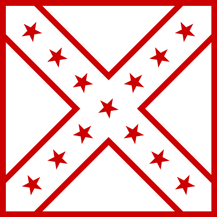 Images from Marc Pasquin, 22 March 2013
Images from Marc Pasquin, 22 March 2013
I saw the cover of Osprey's "American Civil War Armies (5)" which has the image of a Confederate soldier holding a battle flag I have never seen before. Its arrangement is like that of the Army of Northern Virginia Battle Flag, but with a white field and red stars, voided saltire and flag edges. The figure holding it has black waffenfarbe which would make him either part of the Confederate medical branch or of a Texan unit. Beyond that, I have no idea what it represent.
Marc Pasquin, 22 March 2013
 Image from Homepage of Company H, 4th Texas Infantry
Image from Homepage of Company H, 4th Texas Infantry
This appears as plate G3 inside the book. It is the 4th Texas Infantry and the flag still exists. It is a fairly standard Confederate battle flag with red field and blue St. Andrews cross, but the red and blue have faded to white. This fading has led to a misunderstanding that it was originally white, and that error has been copied a few times, including, unfortunately, the Osprey book. The Osprey series are usually quite reliable.
There is an explanation at 4th Texas Battle Flag and another at the Homepage of Company H, 4th Texas Infantry, with a photo of the restored version (wherein the blue cross seems to have been completely replaced while the red field remains faded). [see above]
T.F. Mills, 22 March 2013
 Image from David Phillips, 28 March 2012
Image from David Phillips, 28 March 2012
(Photo credit: Nyein Chan Naing/European Pressphoto Agency, 27 March 2013)
The photo in the (NY Times - March 28, 2013) shows two unfamiliar flags in the foreground as well as a third one indistinctly shown on the tanks in the distance. The foreground flags are unfamiliar to me and not on the FOTW Myanmar army page. Perhaps FOTW might wish to post them as unknown flags clearly in official military use as of March 2013.
David Phillips, 28 March 2013
Does one look like it has a peacock in the centre? I notice also the flag-like design composed by flowers(?) in the background.
Rob Raeside, 28 March 2013
The one on the left looks like defaced Luxembourgian flag... After they defaced the Lithuanian flag for the national flag, maybe they decided to use similarly other national flags for military flag, naval ensigns etc... ![]()
Trying to get back to something a little bit more serious... The blue flag may easily be an (or the) air force flag, in which case, the defaced tricolour may be the army flag or some such... In any case, and in the view of this flag, it seems that the new national flag has more meaning in the shapes than in the colours, so such colour variations may make sense retaining the national symbolism. Such practice would be distinct to the "western" concept of what constitutes a (national) flag and may be a beginning of new development. But, maybe I am jumping ahead too much from a single unexplained photo.
But, on Sulekha.com, we find a photo with other variations of the same theme...
Željko Heimer, 28 March 2013
About the three horizontal striped flag with the star, I know it is the Tanmataw (i.e. Armed Forces) flag. The other, I have a photo where this flag is hoisted at the side of an historical flag, but its use is unknow to me.
Jaume Ollé, 30 March 2013
 Image from Pete Loeser, 30 March 2013
Image from Pete Loeser, 30 March 2013
Apparently, Googling around earlier I found this image, placed it in a unnamed folder, but I can no longer remember where I found it or whose flag it is. It looks like a German municipal flag, but...? Can anybody assist?
Pete Loeser, 31 March 2013
 Image from Klaus-Michael Schneider, 31 March 2013
Image from Klaus-Michael Schneider, 31 March 2013
I am fairly sure that it is the municipal flag of Unterlüß in Celle County (Lower Saxony). I hope, I find a proof. Here is a snapshot of the local CoA
Klaus-Michael Schneider, 31 March 2013
ce-unterluess.gif) Image from Jens Pattke, 1 April 2013
Image from Jens Pattke, 1 April 2013
Michael, die Google-Suchmaschine war gestern, die Zukunft heißt KMS-Suchmaschine. Gratulation für die Identifikation.
(Michael, the Google search engine was yesterday, the future is KMS search
engine. Congratulations for identification.)
Jens Pattke, 1 April 2013
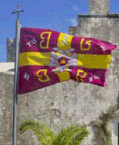 Image from Jens Pattke, 12 May 2013
Image from Jens Pattke, 12 May 2013
In the German travaller magazine das Erbe unserer Welt (page 122), a report on the Ionian islands has been published. In an illustration this flag is unknown to me. Can anyone identify the flag? Maybe it's the flag of the Greek Orthodox Church?
Jens Pattke, 12 May 2013
Yes, this is the flag of the autocephalous Greek Orthodox Church, headed by the Archbishop of Athens. It is briefly mentioned at FOTW here. It is offered for sale at Lonhi, the web shop of Greek
ultra-rightists, as the "Paleologue flag".
On red field, along with four golden firesteels, there is the inscription TOYTO NIKA in white (the second "O" is actually an omega, while "OY" is actually a ligature omicron+upsilon), which is Greek for In hoc signo vinces. The top arm of large golden cross is charged with the chi-rho symbol in white. In center of the flag, there is a white double-headed eagle fimbriated red, charged upon its breast with a red shield with a cross between four firesteels, all in gold, as used in the Byzantine Empire.
Tomislav Todorovic, 12 May 2013